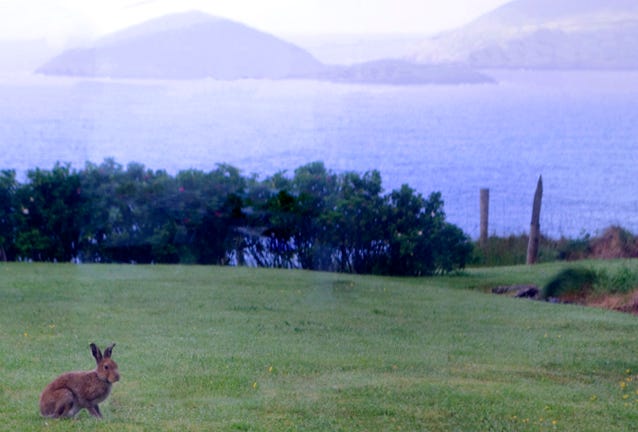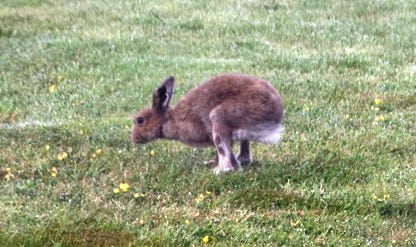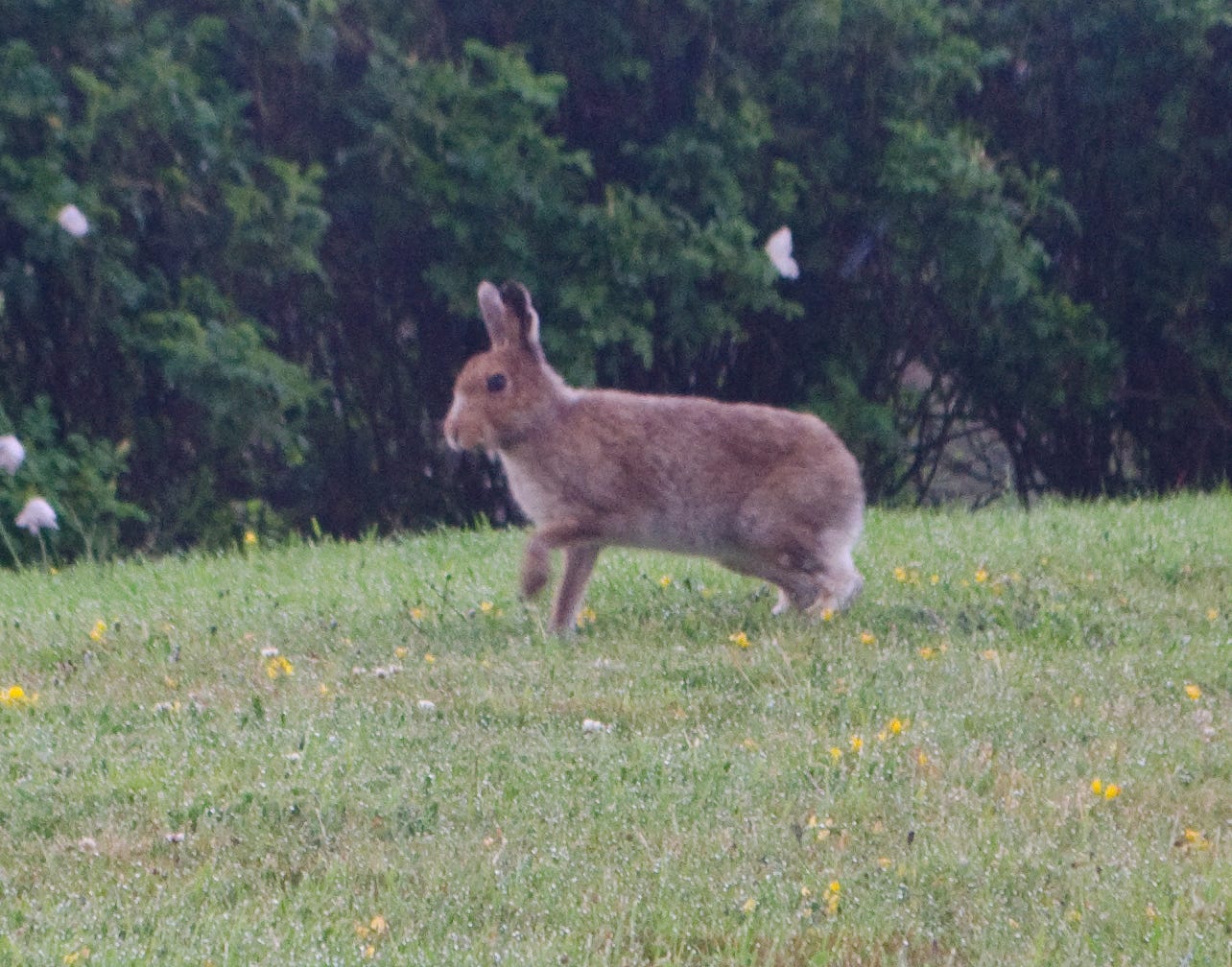The hares are out! Early in the morning, two big hares are gambolling in the next field, all russet red with clean white paws and tails. They squeeze through the wire mesh over the gate and set off across the road and down the stream side. I feel blessed.
Many people think a hare is a hare is a hare (or a jackrabbit, if you live across the Pond). But actually, the Irish Hare is a unique species, related to but unlike the Brown Hare found across Europe (the one with the long flailing ears that appears in artworks and imaginings whenever anyone says “hare”. For a start, the Irish Hare has shorter, black-tipped ears, and if you look at her from behind, you might be fooled into thinking she was merely a rabbit.
But move round to the side, and suddenly, you see those enormous, ridiculous legs, folded up like a grasshopper’s – and then she’s off, zigzagging across the hillside, waving her white (not black) tail. You can almost hear her yelling, “Yaah, can’t catch me!”
The Irish Hare is a subspecies of the Mountain Hare (similar to the Snowshoe Hare), but has so many genetic differences to its European cousins that researchers think it should really be classified as a separate species altogether.
The Irish Hare, Lepus timidus hibernicus, is possibly the oldest species of animal living in Ireland. Fossils found in County Waterford were carbon-dated at nearly 30,000 years old, and it’s thought the hare may have been here far longer than even that.
On Rathlin Island, off the north coast of Ulster, the Irish Hare has lived there so long, with no interbreeding with mainland hares, it has mutated into a unique form – the Rathlin Golden Hare, with a tawny coat and blue eyes.
The Irish Hare’s Gaelic name, Giorria sléibhe Éireannach, means small deer. It’s one of those animals that’s been here so long, it’s become part of the folklore, and has given its name to several places – Ballygirrha in County Cork, for example, the baile (townland) of the hare (Giorria); Dromgurrihy, also in Co. Cork, the “ridge of the hare”; and Meenagarragh in Co. Donegal, the smooth field (mín) of the hare.
Then there’s the saying, “The Hare’s Corner” – a part of a field left wild and uncultivated so that the hare, and other creatures, can thrive, and the Good People will be appeased.
Naturally, for an animal so familiar to people over the centuries, the Irish Hare appears in many, many folk tales and superstitions, particularly associated with dairy producing. When dairy produce was a huge part of the economy, even used for rents, anything that got in the way was thought to be supernatural.
Old women thought to be witches were said to change themselves into hares in order to steal milk directly from cows, and many tales speak of a wounded hare being followed to a cottage where an old woman (or sometimes a beautiful faery maiden) was found bleeding. Such tales originated in Celtic times and are found all over northern Europe.
The Irish Hare was said to be a messenger of the Sidhe (Faery Folk, Good People) who lived in the mounds, or raths, the stone hut circles of Bronze Age people that pepper the countryside, particularly here on the Dingle Peninsula. Many are overgrown with brambles, grass and hawthorn, and although some farmers have cleared away the stones for field walls, many farmers (like our neighbour and his son) still associate them with bad luck. If you see a hare near a rath, you should take its warning and go no closer, since the Good People might come out from beneath and take you down into the earth.
Because the Irish Hare is largely nocturnal, except in the breeding season, she is associated with women and the moon, just like other hares across the world. The Celtic Goddess Eostre reputedly changed into a hare at the full moon (which is why we have the Easter Bunny…). And if you look at a full moon, you will see a hare upside-down. In Australia, they speak of the “Bunny in the Moon”. To see a hare during a full or waxing (growing) moon is good luck.
And in 1893 it was reported that Kerry folk refused to eat the hare in case it held the soul of their grandmother.
It’s not known how the Irish Hare made its way to Ireland, and its unique genetic adaptations suggest it is a remnant of a northern European population that existed before the last Ice Age. This isn’t as fanciful as it seems: there are several plants here that seem to have survived the last ice sheets, as well as the unique Kerry Slug and maybe even the Red Deer of Killarney National Park.
If that wasn’t unusual enough, the Irish Hare also has the distinction of being able to live in a wide range of habitats – from gorse-covered mountainsides to sandy coasts, where it’s been seen grazing on seaweed. It usually eats grasses, sedges, rushes and heather, however.
The Irish Hare doesn’t make a nest or live in a den. She lies very still in a “form”, a scooped out hollow in the dirt or tall grasses, and though she may be in the open field, you’ll never see her unless you walk too close and set her running.
But even if you never see an Irish Hare, it’s wonderful to think she is there somewhere, watching you through the long grass, with all the centuries of knowledge, tradition and belief around her like a cloak: a really special creature with whom we are privileged to share this land.







